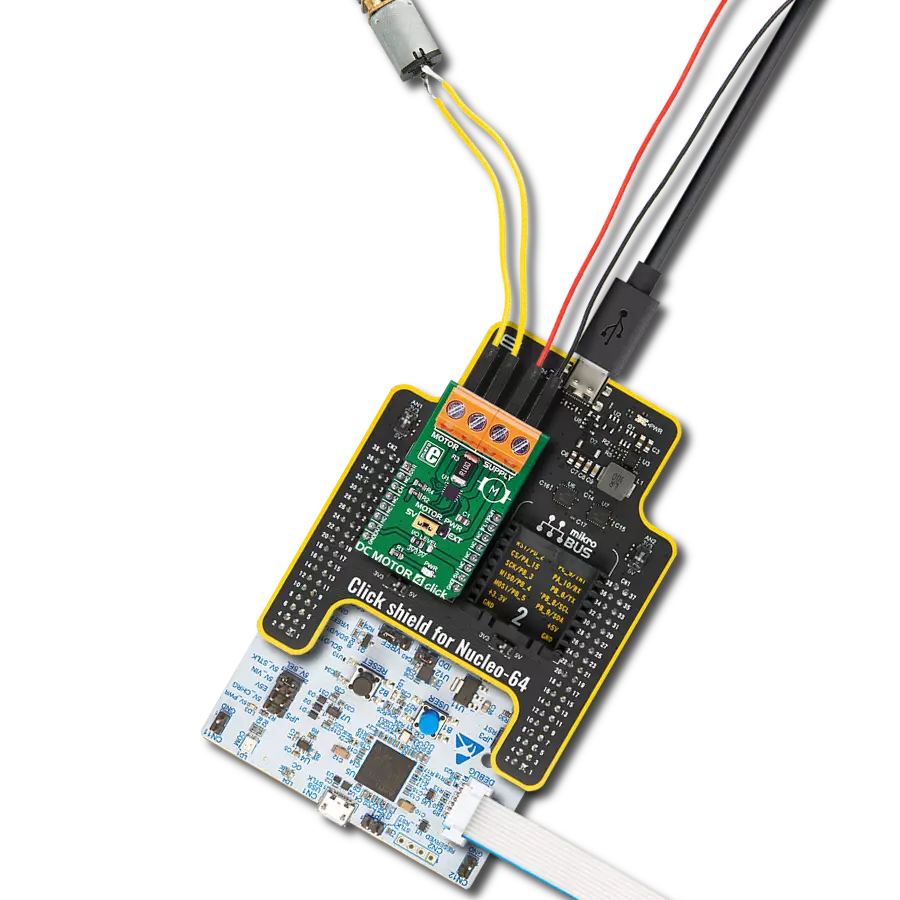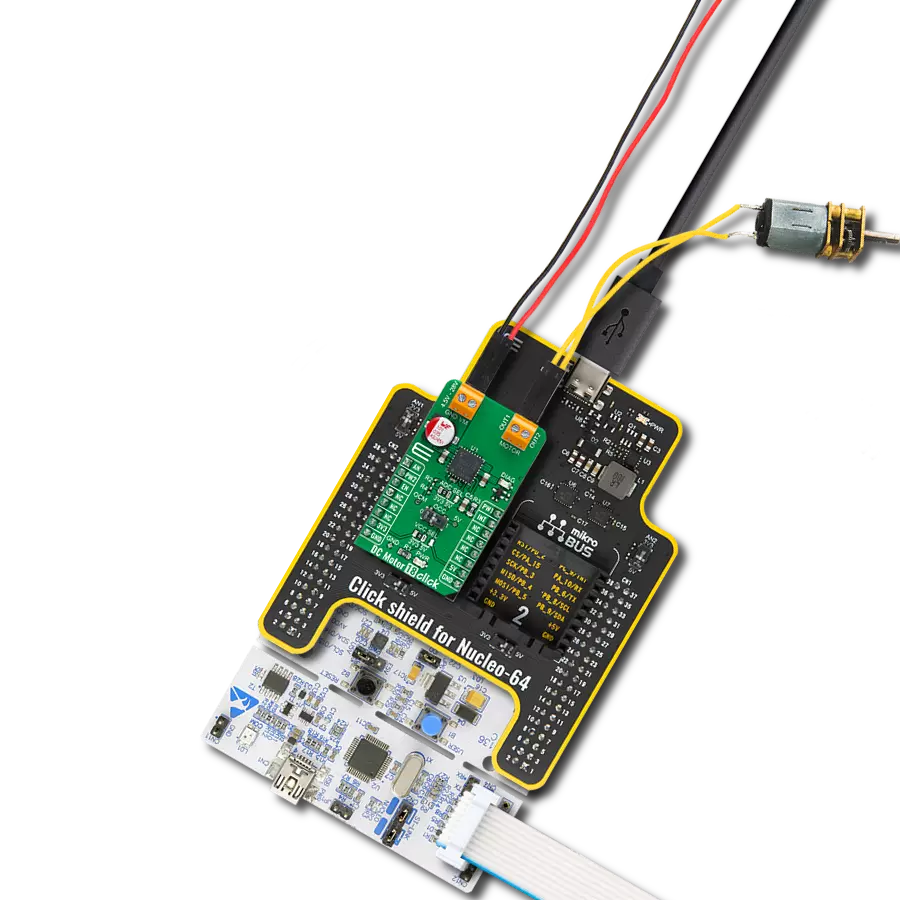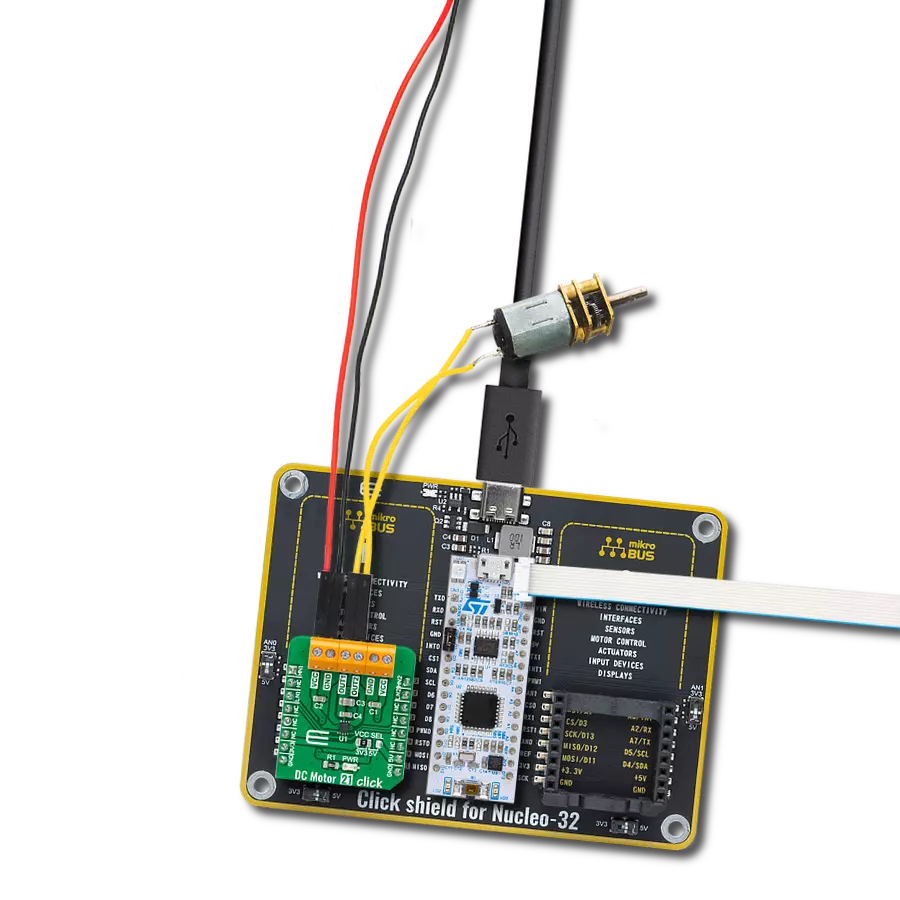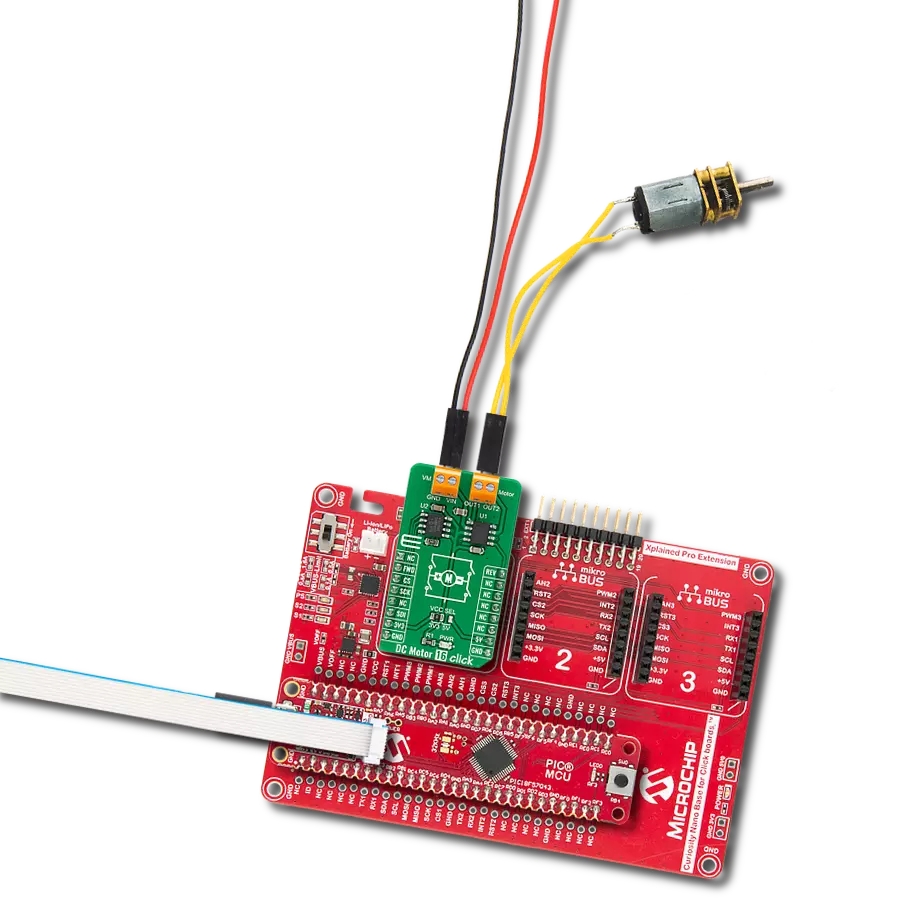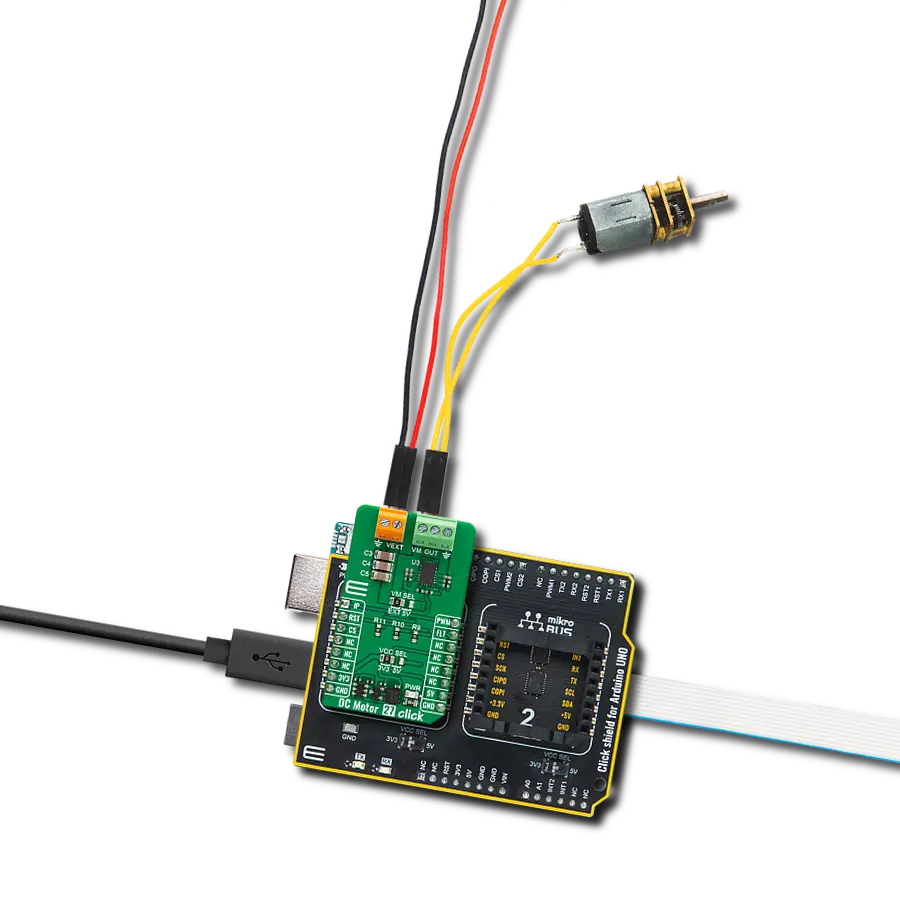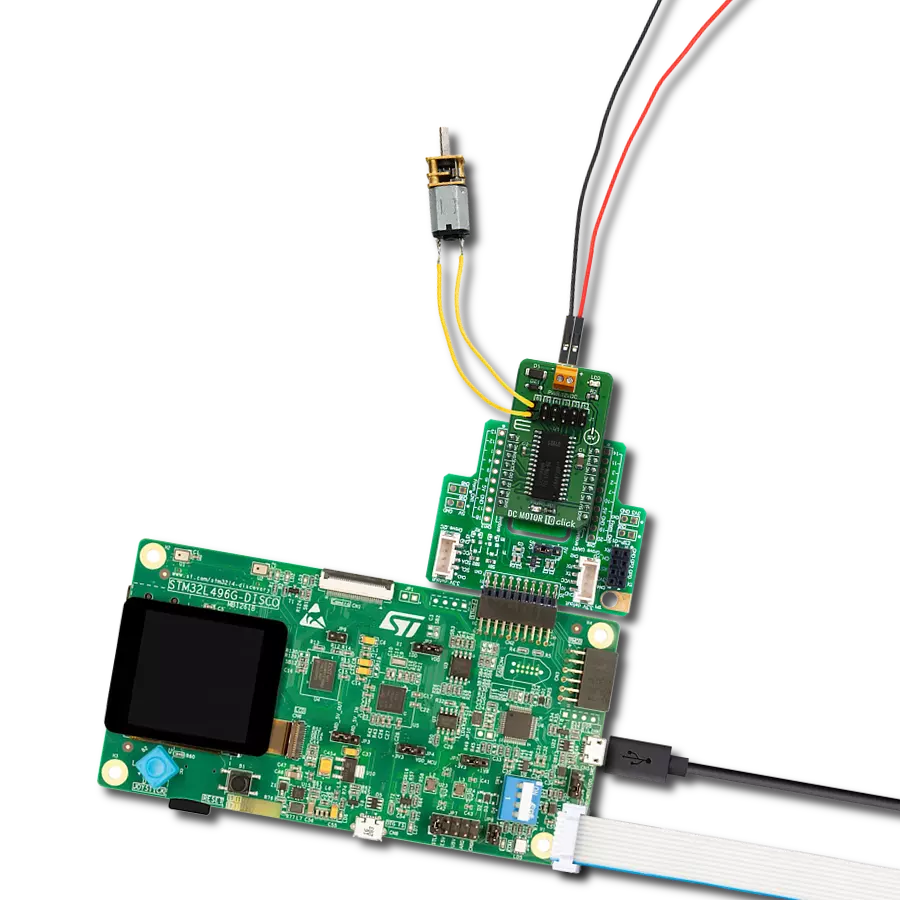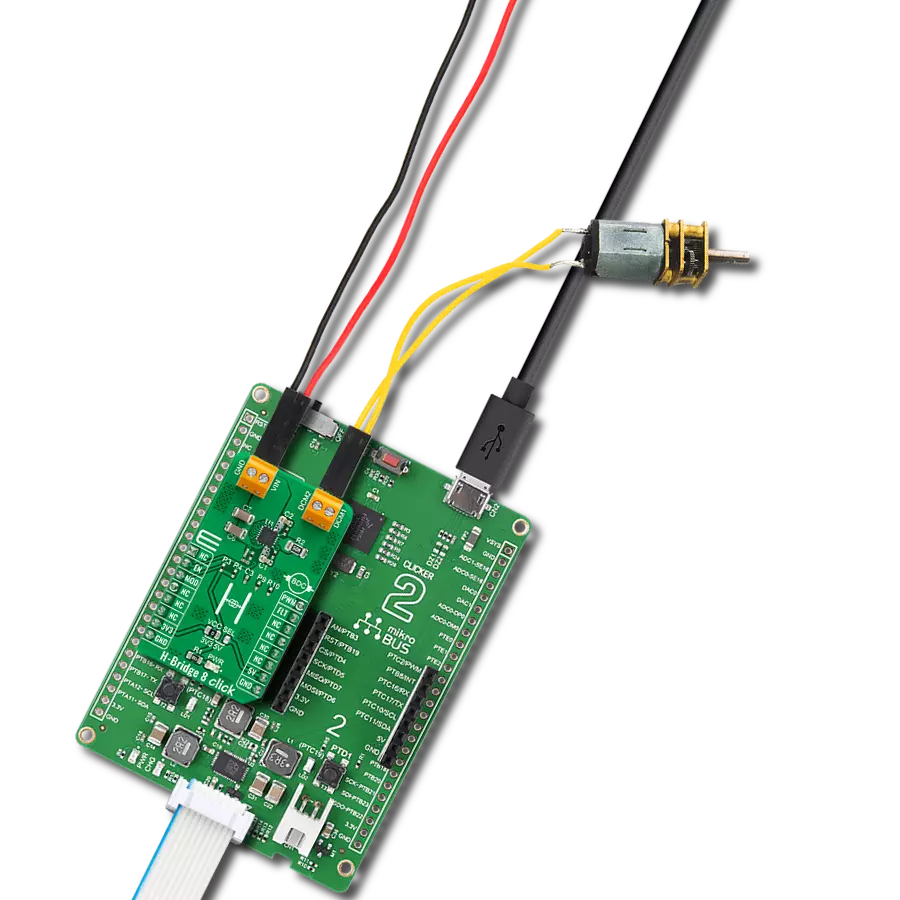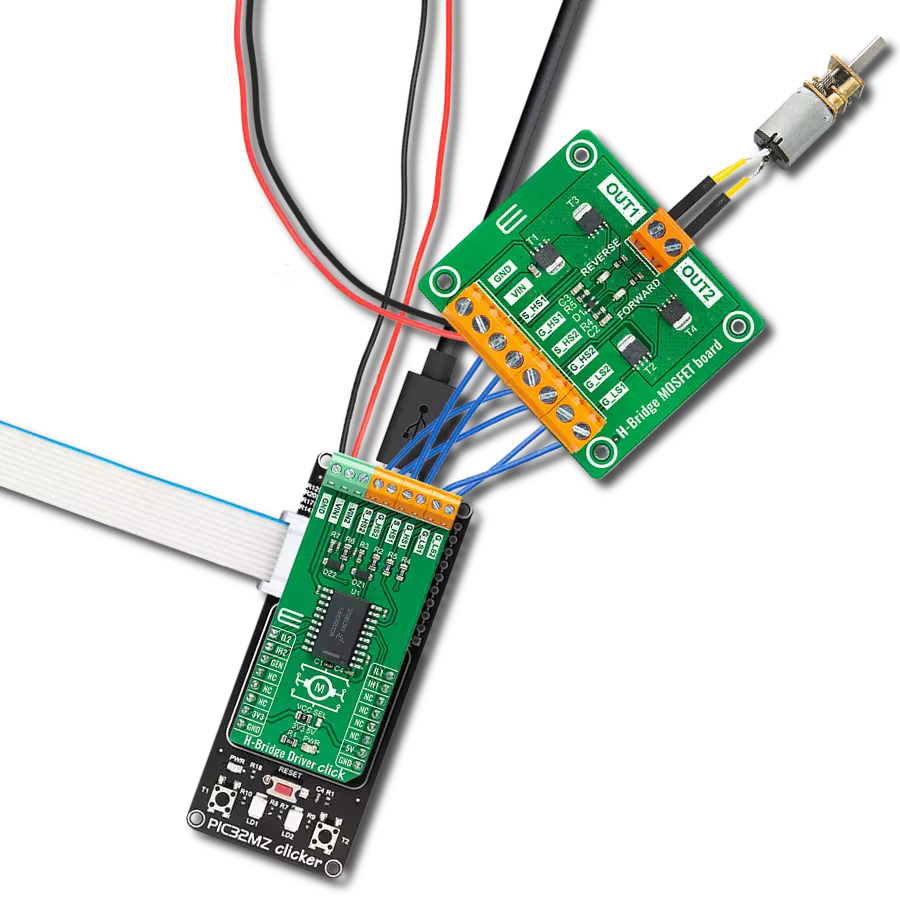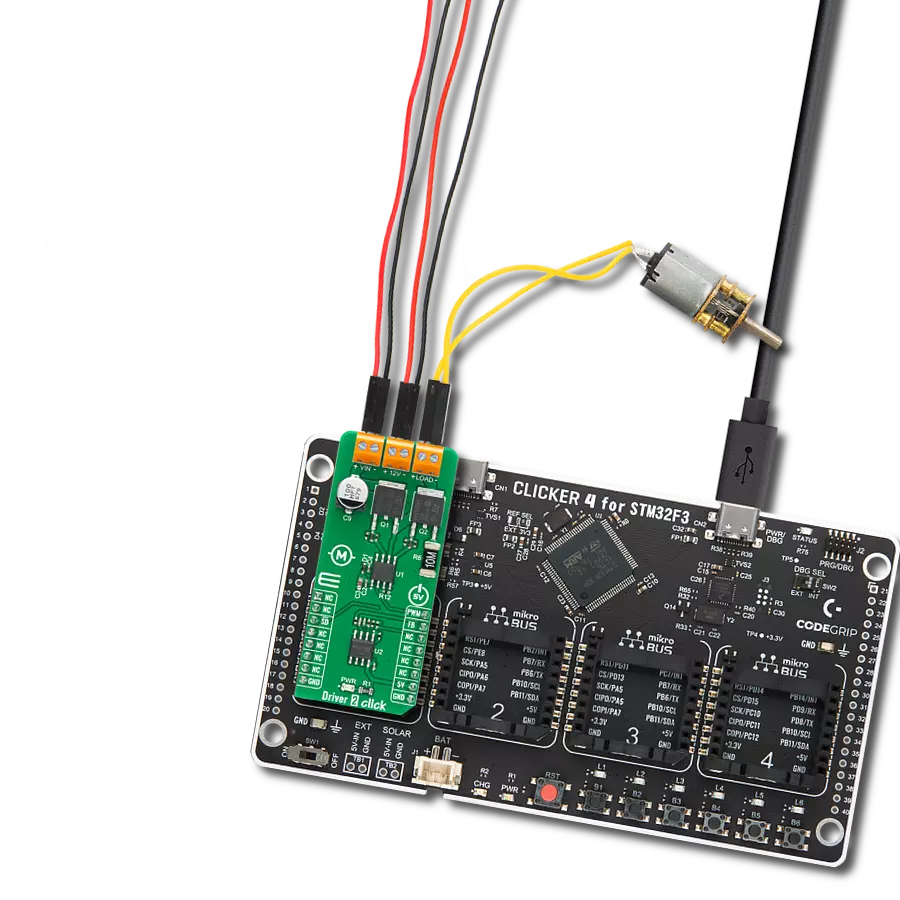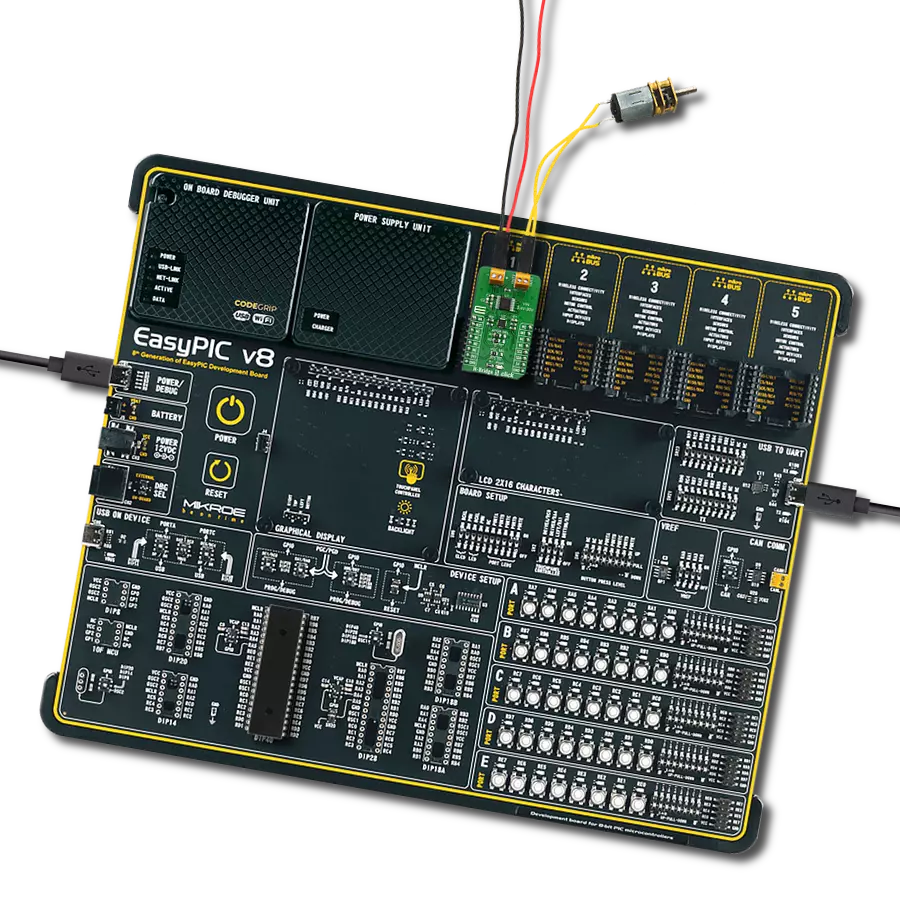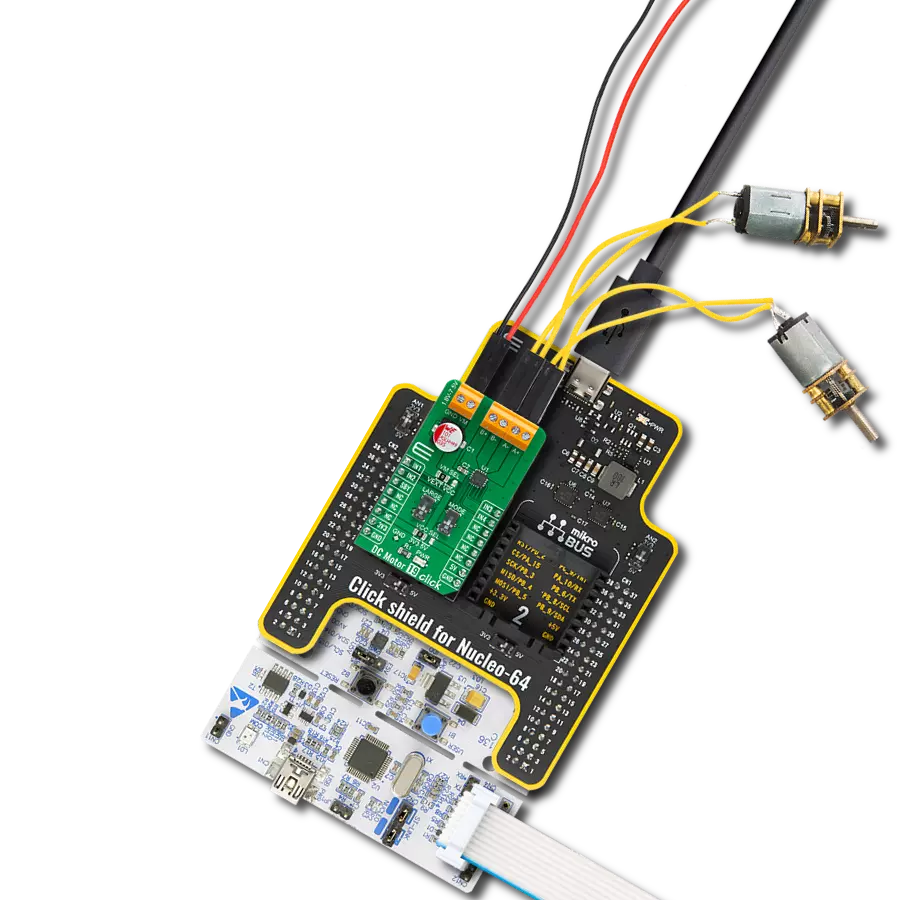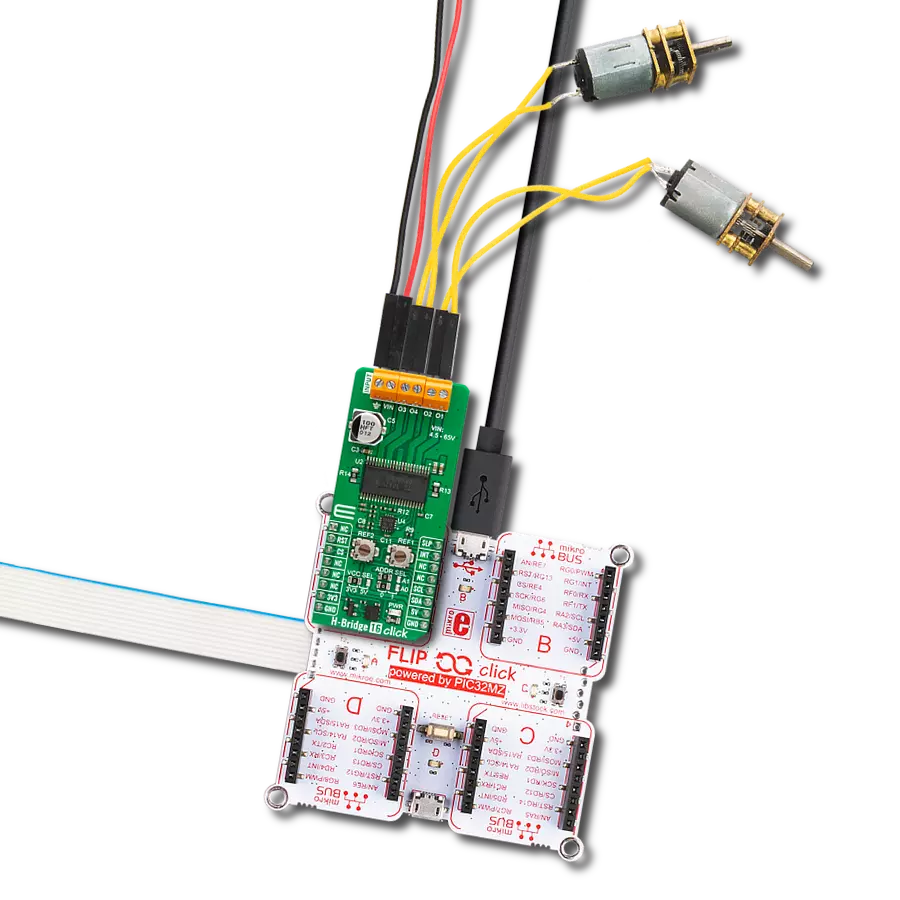Unlock a new era of precision, innovation, and efficiency. Add an H-bridge gate driver with an integrated charge pump and independent high and low side gate driver channels to your design!
A
A
Hardware Overview
How does it work?
H-Bridge Driver Click is based on the MC33883, an H-bridge gate driver (or full-bridge pre-driver) with an integrated charge pump and independent high and low-side driver channels from NXP Semiconductors. Gate driver outputs can source and sink up to 1.0A peak current pulses, permitting large gate-charge MOSFETs to be driven or high pulse-width modulation (PWM) frequencies to be utilized. It also supports a Sleep mode of operation with its low supply current, typical of 10μA. The VIN1 and VIN2 terminals are the power supply inputs to the device. VIN1 is used for the output high-side drivers and the charge pump, while VIN2 is used for the linear regulation. They can be connected together or with different voltage
values, with VIN1 up to 45V and VIN2 up to 28V. These pins also have undervoltage (UV) and overvoltage (OV) shutdown features. If one of the supply voltages drops below the undervoltage threshold or rises above the overvoltage threshold, the gate outputs are switched low to switch off the external MOSFETs. When the supply returns to a level above the UV threshold or below the OV threshold, the device resumes normal operation according to the established condition of the input pins. Four separate pins independently control the gate driver channels, routed to the RST, AN, PWM, and INT pins of the mikroBUS™ socket. Those pins allow the device to be optionally configured as two independent high-side gate
drivers and two independent low-side gate drivers. In addition, it also has a pin used to place the device in Sleep mode. When the GEN pin, routed to the CS pin of the mikroBUS™ socket, is in a logic low state, the device is in Sleep mode; otherwise, it is fully operational. This Click board™ can operate with either 3.3V or 5V logic voltage levels selected via the VCC SEL jumper. This way, both 3.3V and 5V capable MCUs can use the communication lines properly. However, the Click board™ comes equipped with a library containing easy-to-use functions and an example code that can be used, as a reference, for further development.
Features overview
Development board
Nucleo-64 with STM32G474R MCU offers a cost-effective and adaptable platform for developers to explore new ideas and prototype their designs. This board harnesses the versatility of the STM32 microcontroller, enabling users to select the optimal balance of performance and power consumption for their projects. It accommodates the STM32 microcontroller in the LQFP64 package and includes essential components such as a user LED, which doubles as an ARDUINO® signal, alongside user and reset push-buttons, and a 32.768kHz crystal oscillator for precise timing operations. Designed with expansion and flexibility in mind, the Nucleo-64 board features an ARDUINO® Uno V3 expansion connector and ST morpho extension pin
headers, granting complete access to the STM32's I/Os for comprehensive project integration. Power supply options are adaptable, supporting ST-LINK USB VBUS or external power sources, ensuring adaptability in various development environments. The board also has an on-board ST-LINK debugger/programmer with USB re-enumeration capability, simplifying the programming and debugging process. Moreover, the board is designed to simplify advanced development with its external SMPS for efficient Vcore logic supply, support for USB Device full speed or USB SNK/UFP full speed, and built-in cryptographic features, enhancing both the power efficiency and security of projects. Additional connectivity is
provided through dedicated connectors for external SMPS experimentation, a USB connector for the ST-LINK, and a MIPI® debug connector, expanding the possibilities for hardware interfacing and experimentation. Developers will find extensive support through comprehensive free software libraries and examples, courtesy of the STM32Cube MCU Package. This, combined with compatibility with a wide array of Integrated Development Environments (IDEs), including IAR Embedded Workbench®, MDK-ARM, and STM32CubeIDE, ensures a smooth and efficient development experience, allowing users to fully leverage the capabilities of the Nucleo-64 board in their projects.
Microcontroller Overview
MCU Card / MCU
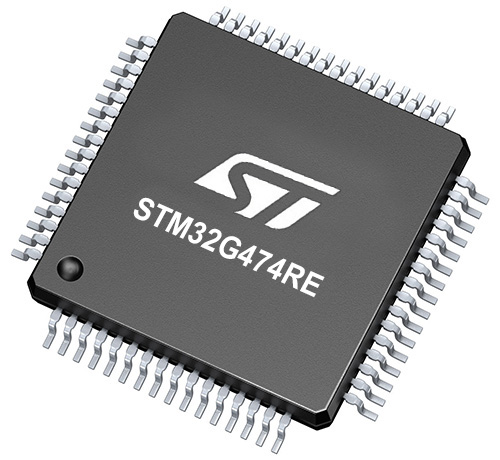
Architecture
ARM Cortex-M4
MCU Memory (KB)
512
Silicon Vendor
STMicroelectronics
Pin count
64
RAM (Bytes)
128k
You complete me!
Accessories
Click Shield for Nucleo-64 comes equipped with two proprietary mikroBUS™ sockets, allowing all the Click board™ devices to be interfaced with the STM32 Nucleo-64 board with no effort. This way, Mikroe allows its users to add any functionality from our ever-growing range of Click boards™, such as WiFi, GSM, GPS, Bluetooth, ZigBee, environmental sensors, LEDs, speech recognition, motor control, movement sensors, and many more. More than 1537 Click boards™, which can be stacked and integrated, are at your disposal. The STM32 Nucleo-64 boards are based on the microcontrollers in 64-pin packages, a 32-bit MCU with an ARM Cortex M4 processor operating at 84MHz, 512Kb Flash, and 96KB SRAM, divided into two regions where the top section represents the ST-Link/V2 debugger and programmer while the bottom section of the board is an actual development board. These boards are controlled and powered conveniently through a USB connection to program and efficiently debug the Nucleo-64 board out of the box, with an additional USB cable connected to the USB mini port on the board. Most of the STM32 microcontroller pins are brought to the IO pins on the left and right edge of the board, which are then connected to two existing mikroBUS™ sockets. This Click Shield also has several switches that perform functions such as selecting the logic levels of analog signals on mikroBUS™ sockets and selecting logic voltage levels of the mikroBUS™ sockets themselves. Besides, the user is offered the possibility of using any Click board™ with the help of existing bidirectional level-shifting voltage translators, regardless of whether the Click board™ operates at a 3.3V or 5V logic voltage level. Once you connect the STM32 Nucleo-64 board with our Click Shield for Nucleo-64, you can access hundreds of Click boards™, working with 3.3V or 5V logic voltage levels.
H-Bridge MOSFET board represents an easy-to-use adapter board that allows the user to exercise all the functions of the H-Bridge Driver Click board™. This board has five 5.08mm pitch screw terminals to connect power and loads easily. Three of them on the left side of the board are suitable for a target H-Bridge Driver Click board™ connection with appropriate high and low side gate drive channels used to control the outputs or functions inside the circuit. The first VIN terminal on the upper-left board side represents the PSMN019-100YLX MOSFET’s power supply connector, allowing an operating voltage range like the connected H-Bridge Driver Click board™. On the right side of the board, the OUT terminal is used to drive a load, such as a brushed DC motor. This board also provides two LED indicators labeled REVERSE and FORWARD to indicate when output operates reverse or forward.
DC Gear Motor - 430RPM (3-6V) represents an all-in-one combination of a motor and gearbox, where the addition of gear leads to a reduction of motor speed while increasing the torque output. This gear motor has a spur gearbox, making it a highly reliable solution for applications with lower torque and speed requirements. The most critical parameters for gear motors are speed, torque, and efficiency, which are, in this case, 520RPM with no load and 430RPM at maximum efficiency, alongside a current of 60mA and a torque of 50g.cm. Rated for a 3-6V operational voltage range and clockwise/counterclockwise rotation direction, this motor represents an excellent solution for many functions initially performed by brushed DC motors in robotics, medical equipment, electric door locks, and much more.
Used MCU Pins
mikroBUS™ mapper
Take a closer look
Click board™ Schematic

Step by step
Project assembly
Software Support
Library Description
This library contains API for H-Bridge Driver Click driver.
Key functions:
hbridgedriver_glo_enable- Global enable functionhbridgedriver_reverse- H-Bridge mode reverse functionhbridgedriver_forward- H-Bridge mode forward function
Open Source
Code example
The complete application code and a ready-to-use project are available through the NECTO Studio Package Manager for direct installation in the NECTO Studio. The application code can also be found on the MIKROE GitHub account.
/*!
* @file main.c
* @brief H-Bridge Driver Click Example.
*
* # Description
* This is an example that demonstrates the use of the H-Bridge Driver Click board.
*
* The demo application is composed of two sections :
*
* ## Application Init
* Initializes GPIO and LOG structures, and sets AN, RST, CS, PWM and
* INT pins as output and start to write log.
*
* ## Application Task
* Demonstrates use of the H-Bridge Driver Click board by turning connected MOSFETs
* gates high or low in order to drive the motor forward, in reverse, brake or coast.
*
* @author Stefan Ilic
*
*/
#include "board.h"
#include "log.h"
#include "hbridgedriver.h"
static hbridgedriver_t hbridgedriver; /**< H-Bridge Driver Click driver object. */
static log_t logger; /**< Logger object. */
void application_init ( void )
{
log_cfg_t log_cfg; /**< Logger config object. */
hbridgedriver_cfg_t hbridgedriver_cfg; /**< Click config object. */
/**
* Logger initialization.
* Default baud rate: 115200
* Default log level: LOG_LEVEL_DEBUG
* @note If USB_UART_RX and USB_UART_TX
* are defined as HAL_PIN_NC, you will
* need to define them manually for log to work.
* See @b LOG_MAP_USB_UART macro definition for detailed explanation.
*/
LOG_MAP_USB_UART( log_cfg );
log_init( &logger, &log_cfg );
log_info( &logger, " Application Init " );
// Click initialization.
hbridgedriver_cfg_setup( &hbridgedriver_cfg );
HBRIDGEDRIVER_MAP_MIKROBUS( hbridgedriver_cfg, MIKROBUS_1 );
if ( DIGITAL_OUT_UNSUPPORTED_PIN == hbridgedriver_init( &hbridgedriver, &hbridgedriver_cfg ) )
{
log_error( &logger, " Communication init." );
for ( ; ; );
}
hbridgedriver_glo_enable( &hbridgedriver, HBRIDGEDRIVER_PROP_EN );
Delay_ms ( 100 );
log_info( &logger, " Application Task " );
}
void application_task ( void )
{
log_printf( &logger, " The motor turns forward! \r\n" );
hbridgedriver_forward( &hbridgedriver );
Delay_ms ( 1000 );
Delay_ms ( 1000 );
Delay_ms ( 1000 );
log_printf( &logger, " The motor brakes! \r\n" );
hbridgedriver_braking( &hbridgedriver );
Delay_ms ( 1000 );
Delay_ms ( 1000 );
Delay_ms ( 1000 );
log_printf( &logger, " The motor turns in reverse \r\n" );
hbridgedriver_reverse( &hbridgedriver );
Delay_ms ( 1000 );
Delay_ms ( 1000 );
Delay_ms ( 1000 );
log_printf( &logger, " The motor coasting \r\n" );
hbridgedriver_coasting( &hbridgedriver );
Delay_ms ( 1000 );
Delay_ms ( 1000 );
Delay_ms ( 1000 );
}
int main ( void )
{
/* Do not remove this line or clock might not be set correctly. */
#ifdef PREINIT_SUPPORTED
preinit();
#endif
application_init( );
for ( ; ; )
{
application_task( );
}
return 0;
}
// ------------------------------------------------------------------------ END
Additional Support
Resources
Category:Brushed





















